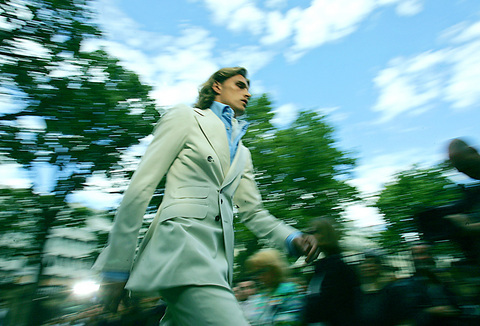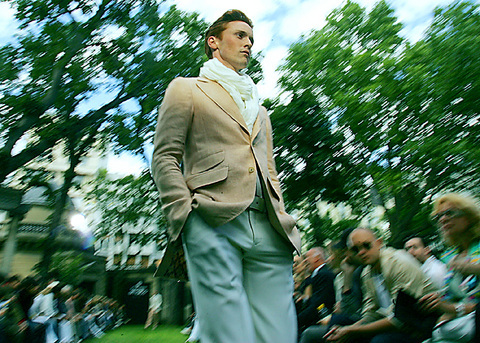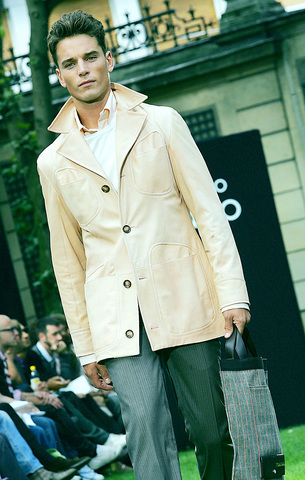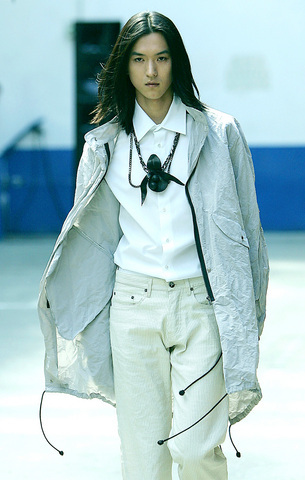The world's top menswear designers this week have unveiled a wealth of options for next summer on the Paris catwalk, from the ultimate vacation wardrobe at Louis Vuitton to smart tailoring at Francesco Smalto.
At Vuitton, US designer Marc Jacobs served up the perfect apparel for the billionaire playboy planning to spend summer next year tanning on his yacht in the Mediterranean -- shorts, tank tops, sandals and beach towels.
But these were no ordinary summer closet staples, as the shorts came in silk or suede, and the sandals were crafted from crocodile leather. As for the towels, they were emblazoned with the Louis Vuitton logo.

Ultra-fine sweaters topped one or two crinkled silk shirts that clung to the chest. Jacobs went for a more casual look with dark blue jeans and silk blouson jackets with "Louis Vuitton" written in baseball-style script on the back.
For a night out at the casino in Monte Carlo, no problem -- Jacobs offered a mohair tuxedo over the perfect cotton ruffle-front shirt. As for a weekend bag, one with a chain-link pattern and the famed LV monogram should do just fine.
Franck Boclet, the artistic director for Francesco Smalto, would be comfortable in a job on Savile Row. He stayed true to the house's reputation for sharp tailoring with a collection of smart suits.

Boclet fitted his models to a tee, with impeccable straight-leg trousers and jackets that emphasized the models' broad shoulders. Checks and pinstripes added a bit of character, as did formal tuxedo shirts.
The Smalto man is decidedly masculine, but isn't afraid to wear a patterned jacket in flesh tones or a suede shirt jacket. Belted leather coats in mocha or maize cut a less formal, but still chic, silhouette.
Kenzo -- part of the stable of brands owned by luxury goods giant LVMH -- joined a number of menswear labels, including Issey Miyake and Yohji Yamamoto, that have looked this season to the elegance of 1930s sportsmen.

Laid-back suits with subtle embroidered tone-on-tone floral patterns in white or cream seemed perfect for a day at the races or the yacht club, especially when paired with a striped navy shirt.
Florals, stripes and checks in browns and beiges or pastels combined to create a more bohemian chic look. A petal pink belted trench would work for the budding artist. Rough-cut patches added texture to suit jackets.
After years of showing women's and men's designs together, Belgium's Ann Demeulemeester staged her first menswear catwalk show in the French capital, unveiling a line that combined comfort, urban cool and a hint of femininity.

Long-haired, androgynous models sported full-cut trousers that were rolled above the ankle or roomy breeches, striped shirts that fell asymmetrically at the hip and full jackets in soft linen or cotton.
A cream waistcoat with soft rose pin dots or a jacket in royal blue added notes of color to the collection, in contrast to Demeulemeester's preferred black. For evening, men can make an impression with a simple black tuxedo shirt.
Walter van Beirendonck, who with Demeulemeester is one of the famed "Antwerp Six" from the northern Belgian city, returned to Paris men's fashion week with an artistic statement, rare in an industry where sales so often rule.

PHOTOS: AGENCIES
For his "Relics from the Future" show, van Beirendonck placed models with afros in tribal make-up atop podiums in a Paris gallery courtyard wearing frock coats embroidered with insects along the lapels and orange vinyl trousers.
An ornate watch was stitched into a black wristband, while open-toed wooden clogs bore cross-stitch motifs. Van Beirendonck may not make mass-market clothes, but his work offered a welcome breath of fresh air.
Men's fashion week in Paris wrapped up this week with the next spring-summer collection from Ozwald Boateng for Givenchy and Hedi Slimane for Dior, as well as the debut of US designer Thomas Engelhart for Thierry Mugler Homme.

May 11 to May 18 The original Taichung Railway Station was long thought to have been completely razed. Opening on May 15, 1905, the one-story wooden structure soon outgrew its purpose and was replaced in 1917 by a grandiose, Western-style station. During construction on the third-generation station in 2017, workers discovered the service pit for the original station’s locomotive depot. A year later, a small wooden building on site was determined by historians to be the first stationmaster’s office, built around 1908. With these findings, the Taichung Railway Station Cultural Park now boasts that it has

Wooden houses wedged between concrete, crumbling brick facades with roofs gaping to the sky, and tiled art deco buildings down narrow alleyways: Taichung Central District’s (中區) aging architecture reveals both the allure and reality of the old downtown. From Indigenous settlement to capital under Qing Dynasty rule through to Japanese colonization, Taichung’s Central District holds a long and layered history. The bygone beauty of its streets once earned it the nickname “Little Kyoto.” Since the late eighties, however, the shifting of economic and government centers westward signaled a gradual decline in the area’s evolving fortunes. With the regeneration of the once

In February of this year the Taipei Times reported on the visit of Lienchiang County Commissioner Wang Chung-ming (王忠銘) of the Chinese Nationalist Party (KMT) and a delegation to a lantern festival in Fuzhou’s Mawei District in Fujian Province. “Today, Mawei and Matsu jointly marked the lantern festival,” Wang was quoted as saying, adding that both sides “being of one people,” is a cause for joy. Wang was passing around a common claim of officials of the People’s Republic of China (PRC) and the PRC’s allies and supporters in Taiwan — KMT and the Taiwan People’s Party — and elsewhere: Taiwan and

Even by the standards of Ukraine’s International Legion, which comprises volunteers from over 55 countries, Han has an unusual backstory. Born in Taichung, he grew up in Costa Rica — then one of Taiwan’s diplomatic allies — where a relative worked for the embassy. After attending an American international high school in San Jose, Costa Rica’s capital, Han — who prefers to use only his given name for OPSEC (operations security) reasons — moved to the US in his teens. He attended Penn State University before returning to Taiwan to work in the semiconductor industry in Kaohsiung, where he